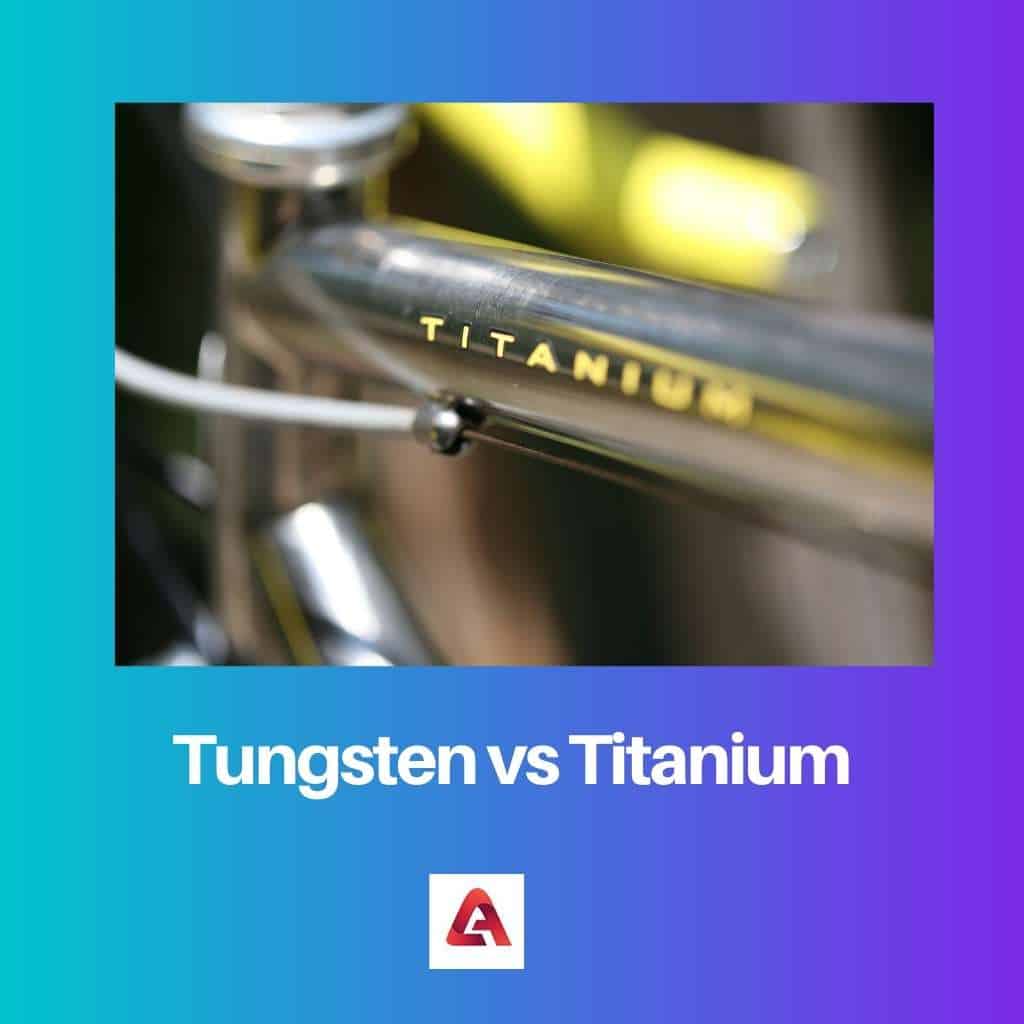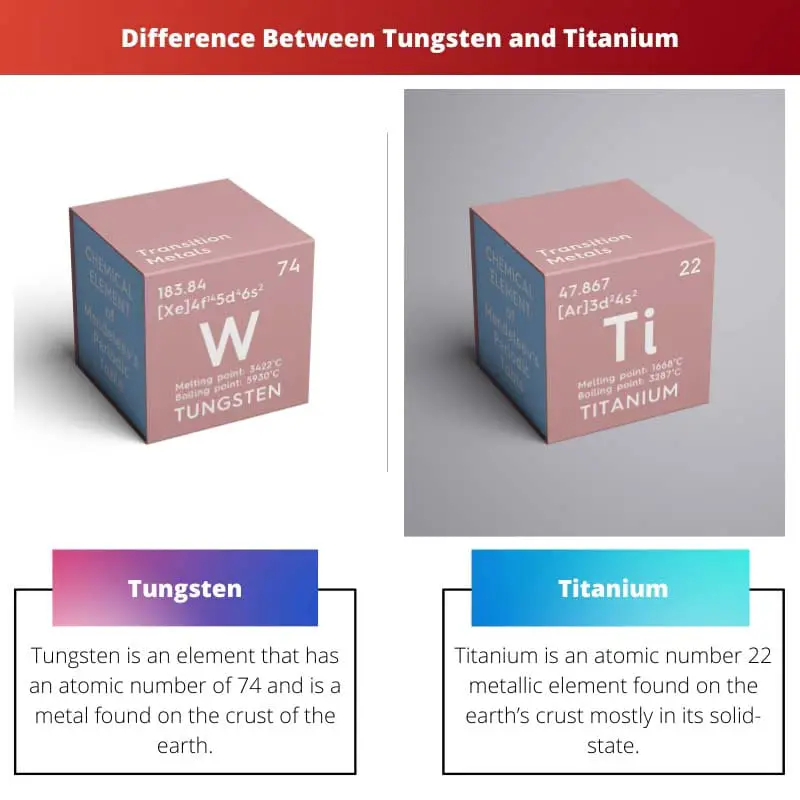Titanium and tungsten are two elements found in nature in their solid form at most times and have many uses. Their prime use is in the making of jewelry and used for accessorizing places.
They provide the classic shine like the rest of their jewelry metal counterparts like gold, platinum, and silver. They also have many other uses in other fields for making types of equipment, etc.
Key Takeaways
- Tungsten is denser and heavier than titanium, making it more durable and scratch-resistant.
- Titanium is a lighter, more flexible metal with excellent corrosion resistance and biocompatibility.
- Tungsten has a higher melting point than titanium, making it suitable for high-temperature applications.
Tungsten vs Titanium
The difference between tungsten and titanium is that while titanium is in a much lower position in the periodic table with an atomic number of 22, tungsten is much higher in its position in the periodic table with a greater atomic number of 74. This difference in the position of elements in the periodic table gives each element the differences in both their physical as well as chemical properties.

Tungsten has an atomic number of 74 and is located towards the left side of the periodic table a bit closer to the metals.
It has all the properties that make it the best element to be used in place of many other elements that are used in making jewelry. Other features of tungsten include its shining nature that gives jewelry extra bling while being made.
Titanium is an element located on the right side of the periodic table along with all the metals and has an atomic number of 22. All of the titanium properties help it in jewelry production as well as in its assistance in nuclear power plants.
It is very rare and the places of its extraction have a high GDP value.
Comparison Table
| Parameters of Comparison | Tungsten | Titanium |
|---|---|---|
| Mohs Resistance | 8-9 | 6 |
| Melting Point | 6192 F | 3032 F |
| Chemical Symbol | W | Ti |
| Atomic Number | 74 | 22 |
| Color In Solid State | Dark grey | Light metallic grey |
What is Tungsten?
Tungsten is an element that has an atomic number of 74 and is a metal found on the crust of the earth.
It is extracted in its solid form but on very rare occasions tungsten is also found in gaseous as well as liquid form.
It has a chemical symbol that is more commonly used to refer to the element as its real name is a bit hard. The chemical symbol is the English alphabet W.
The natural form of tungsten comes in a slight grayish to a dark metallic color. This is understood as its closeness to graphite in the table is justified.
They all have similar chemical as well as physical properties.
Tungsten has a high melting point and is a very hard and highly resistant metal.
It has a Mohs resistance order of 8 or 9 and is one of the highest for metals.
Mohs resistance is the scale that is used to measure the scratch resistivity of any element and the depth of each scratch as well as the effect on the material.
As tungsten is even scratch resistant to such a high level, it’s normal for its melting point to be as high as 6192 Fahrenheit.
Tungsten is commonly known for the weight of the element. It weighs heavy even for a small milligram of the metal.
Among most of its physical characteristics, its weight is one of the things that highlight its usage as a jewelry-making metal.
The weight creates a path for a smaller amount of metal that could be rolled into the desired jewel.
This is a cost-effective way to make custom jewelry such as wedding rings and wedding bands.
Tungsten is very hard to engrave messages or names on as part of customary jewelry like wedding bands.
Due to its hardness, tungsten rings are engraved with laser-like light to create a smooth and shiny cut.
Such laser engravings don’t leave a way for dirt to accumulate in the corners and stay there.
What is Titanium?
Titanium is an atomic number 22 metallic element found on the earth’s crust mostly in its solid-state.
This is fairly easy to extract elements for its most common form available in nature is its solid form found accumulated in between rocks under the crust.
The chemical symbol that is used for ease of usage of the element name is Ti. It is short for titanium by giving the first two letters of the element.
It has a solid metallic grey color while in its ore and this color doesn’t see much change even after going through all the processes of extracting from the metallic ore.
Titanium has a comparatively low melting point which is accompanied by its lightweight physical property.
The lightest quality of the titanium metal is called the “aircraft”. This is used for making modern jewelry and parts of phones and tablets.
Couples prefer to find alternatives to classic gold jewelry and silver ornaments for wedding rings and bands.
Instead, they now prefer to use the contemporary style of jewelry making with much more shine and malleable properties like titanium.
The Mohs resistance for titanium is 6 which is pretty high when compared to gold, silver, and platinum none of which come above 4.5.
This scratch resistivity is a highly liked factor about titanium when used for making jewelry.
It is also harder than most other metals used for making bands and rings. This gives it a greater value as it can hold up pretty well to all kinds of external forces.
It is not known to tarnish easily and has a shine that lasts for a longer amount of time.
Due to its lightweight, it is easier to engrave things onto titanium for customized wedding rings.
Titanium is also used for the construction of many types of equipment and other objects used in a nuclear power plant.

Main Differences Between Tungsten and Titanium
- While the chemical symbol of tungsten is the English alphabet “W”, the chemical symbol for titanium is in the form of two English alphabets and is ” Ti”.
- Titanium being a much lighter element is easier to engrave things onto whereas tungsten is really hard to engrave things on and laser cuts have to be used.
- While the melting point of titanium is very low, that of tungsten is high and is measured in Fahrenheit or kelvin.
- The atomic number of tungsten is 74 and the atomic number of titanium is only 22, which indicates that they are both slightly different in their physical and chemical properties.
- The color of tungsten in its solid state is a dark metal whereas the color of titanium in its solid state is a bit lighter and a slight metallic grey.




